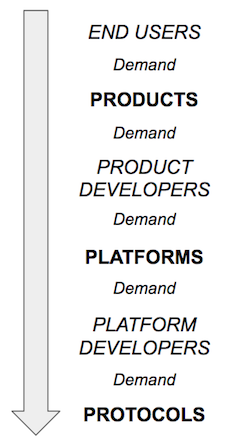Don’t Obsess Over Crypto End Users, We Still Need Developers to Build the Back End
Jill Carlson, a CoinDesk columnist, is co-founder of the Open Money Initiative, a non-profit research organization working to guarantee the right to a free and open financial system. She is also an investor in early stage startups with Slow Ventures.
Where are the users?
This is the big question facing the cryptocurrency and blockchain technology world. For some, it is the elephant in the room. For others, it is the tantalizing puzzle waiting to be solved. For everyone, it is a matter of survival.
Related: No, Concentration Among Miners Isn’t Going to Break Bitcoin
A couple of years ago, I wrote a bit about how I conceive of the blockchain technology stack. The stack breaks down into three layers: products, platforms and protocols.
Products serve end users
Platforms serve product developers
Protocols serve platform & product developers
Products include assets like cryptocurrencies and tokens as well as the applications they enable, such as games and marketplaces. Platforms are developer environments and middleware layers that allow those assets and applications to be built and run. Protocols are the underlying networks and their associated rules.

I also wrote, a couple of years ago, about how demand, and therefore value, flows from end users, through products and eventually back to the platforms and protocols that underlie them. I called this dynamic “top-down demand.”

At the time that I wrote all of this, in the fall of 2017, at the peak of initial coin offering fever, I was imploring the market to pay closer attention to fundamentals. I hoped founders, developers and creators would pause in their quest for optimization for optimization’s sake (invariably building a better, faster, more secure ethereum) and instead think from first principles about who might actually want such a thing. I wished for the market to place greater focus on end users as opposed to chanting the old Steve Ballmer reprise: “Developers! Developers! Developers!”
Related: Financial Services: The Coming Cataclysm
I am writing about all of this now because I think, in a way, I was wrong. At a minimum, I think that as an industry we have overcorrected. Two years ago I would have told you the industry needed to focus on end consumers. Today I see this with more nuance.
Outside of the weird, wonderful world of cryptocurrency, startups tend to fall into one of a few categories when it comes to go-to-market strategy. They can be B2C (businesses selling directly to consumers), B2B (businesses selling to other businesses or enterprises), or they can be B2B2C. As you may have surmised, B2B2C businesses sell their products to other businesses that in turn pass the product on to their customers. Importantly, B2B2C companies are in the business of acquiring those end users.
We must not only build products people want but also build platforms developers need to get there.
OpenTable is a great example of this. OpenTable started out much as it exists today: a platform for restaurant-goers to make reservations. Quickly, however, the OpenTable team realized the restaurants did not have the pieces in place to enable this. The restaurants were still taking reservations over the phone and noting them down using pens and clipboards. So OpenTable built out a digital CRM and table management system, selling restaurants the infrastructure they needed to get online. Once they had a critical mass of restaurants on the platform, they could close the loop by once more providing a reservation-booking product to end consumers.
I think the blockchain industry can take some lessons from OpenTable. As I rethink the products, platforms and protocols framework, I see parallels to B2B2C businesses. What we need is not, as I advocated for at the time, a greater focus on end consumers. As I look around today, all I see in the cryptocurrency world are strong hypotheses about what end-consumers might want: open access to investment products, freely transferable gaming assets, immutable digital memory, certifiably-scarce digital goods. What is missing is the infrastructure that enables these products.
Users are generally the sign that product-market fit has been achieved. The challenge of the blockchain world lies not only in reaching product-market fit, but also in achieving protocol-market fit. For this, we must not only build products people want but also build platforms developers need to get there. It’s not all about the wants and needs of end users. It’s also about the wants and needs of the developers and dreamers who will get us there.
